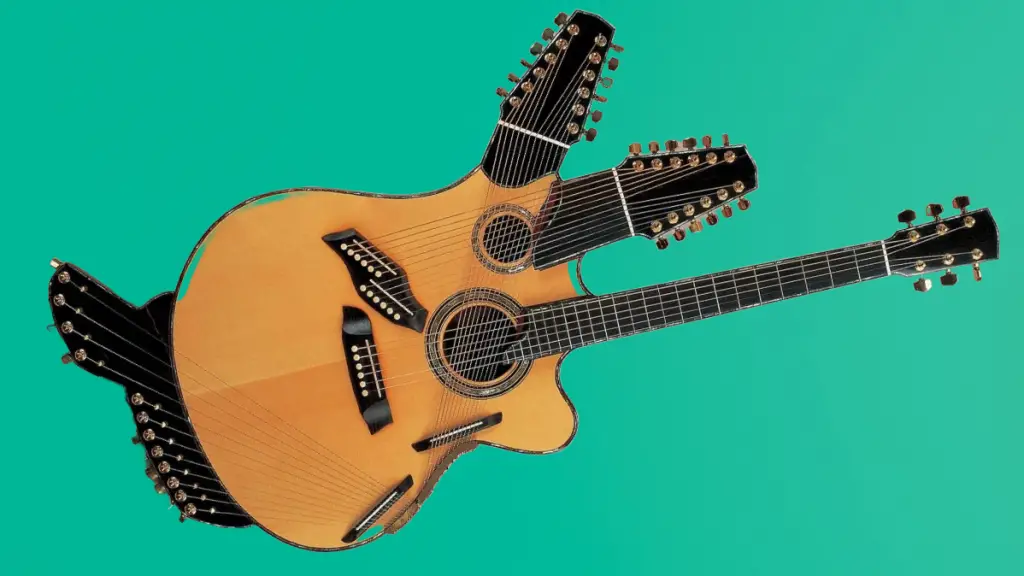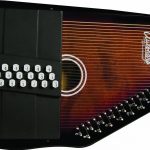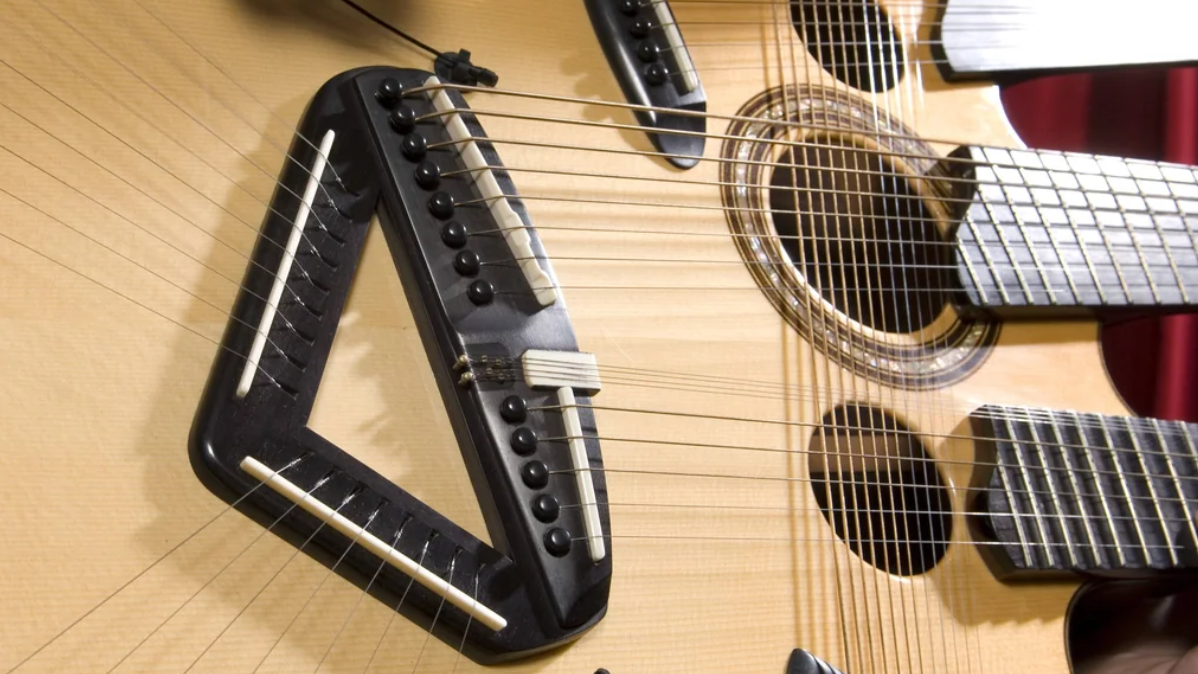What is a Pikasso Guitar? Exploring the Unique Multi-Necked Instrument
Folkstrings.com is reader-supported. When you buy through links on our site, we may earn a small commission.
The Pikasso guitar is an intriguing instrument that captures the eye and ear with its unique design and sound. Crafted by the master luthier Linda Manzer for the jazz guitarist Pat Metheny, it’s a distinct creation unlike any standard guitar.
Its name draws inspiration from the famed artist Pablo Picasso, reflecting the guitar’s avant-garde and multi-dimensional structure. With a staggering 42 strings and three necks, the Pikasso guitar not only pushes the boundaries of traditional guitar-making but also offers a wide palette of sonic possibilities.

Playing the Pikasso guitar requires a specialized set of techniques, but it rewards players with its exceptional range and versatility. From its inception, it was designed to offer Metheny an array of harmonic and melodic opportunities that a typical guitar could not provide.
Despite its complexity, the Pikasso guitar retains a warm and resonant tone, a testament to Linda Manzer’s craftsmanship. The guitar has since become an iconic piece in the world of music, celebrated for its innovative approach to the traditional instrument.
Key Points
- The Pikasso guitar is a one-of-a-kind instrument made by Linda Manzer for Pat Metheny.
- This guitar features 42 strings and three necks, offering expansive musical possibilities.
- It is known for both its unique design and the specialized playing techniques it requires.
History and Concept of the Pikasso Guitar
The Pikasso guitar is a distinctive and visually complex stringed instrument, a result of creative minds intersecting across different fields. At its core, it is a manifestation of artistic innovation and musical exploration.
Inspiration from Pablo Picasso
The Pikasso guitar’s story begins with the artist Pablo Picasso, who was known for his revolutionary approach to visual art. His ability to deconstruct and reassemble objects in abstract forms directly influenced the guitar’s conceptual design.
Picasso’s paintings that included guitars often featured them in a fragmented, Cubist style, challenging the traditional representation of both space and the instrument itself.
Creation by Luthier Linda Manzer
Luthier Linda Manzer crafted this unique instrument in 1984, showcasing her expertise in guitar making. The Pikasso guitar stands out because of its multiple necks and a staggering 42 strings, arranged in a complex array that pushes the boundaries of traditional guitar design.
Manzer’s meticulous work resulted in an instrument that is not just playable but is also a piece of visual art.
Pat Metheny’s Collaboration and Usage
The collaboration between Linda Manzer and the celebrated jazz guitarist Pat Metheny is also noteworthy. Metheny commissioned the Pikasso guitar for his eclectic and bold musical pursuits, which needed an instrument capable of producing a broader palette of sounds.
The guitar became iconic through its use on Metheny’s album “Imaginary Day,” where its unique tonal possibilities were fully explored. Metheny’s virtuosic performances using the Pikasso have solidified the instrument’s place in the annals of modern music history.
Design and Characteristics
In exploring the innovative Pikasso guitar, I’m struck by its unique design, which directly influences its rich tone. This guitar stands out with its multi-neck configuration, a complex string arrangement with 42 strings, and the use of fine woods such as German spruce, mahogany, and ebony.
Multi-Neck Configuration
The Pikasso guitar sports a distinctive multi-neck setup which includes two sound holes and three necks, one of which is a fretless 11-string harp sector. This design not only contributes to the guitar’s signature look but also expands its range of playable music.
String Arrangement and Tuning
My attention is quickly drawn to the instrument’s 42 strings, which require precise tuning. The Pikasso guitar’s layout is meticulously organized, with two six-string necks tuned to standard guitar pitch and an additional third neck arranged with string pairs following a mandolin’s tuning.
- Standard Neck Tuning: EADGBE
- Mandolin Neck Tuning: Courses tuned in fifths
Materials and Craftsmanship
The choice of tonewoods in the Pikasso guitar is essential to its tone and playability. I appreciate the top-quality German spruce for the soundboard, offering resonance and clarity. Mahogany, used in the body and necks, provides a warm and balanced sound, while ebony is utilized for the fingerboards due to its durability and smooth texture.
The “Manzer Wedge,” a tapered body design, is a clever crafting addition that enhances the guitar’s ergonomic comfort without sacrificing the instrument’s tonal qualities.
Playing Techniques and Performances
The Pikasso guitar, with its array of strings and unique structure, compels the player to adopt specialized playing techniques. Artists like Pat Metheny, who have mastered this instrument, display a mesmerizing blend of traditional and innovative methods in their performances.
Adaptations for Complexity
The Pikasso guitar, designed by luthier Linda Manzer for Pat Metheny, features 42 strings and multiple necks. Its intricate design goes beyond the standard 6 or 12-string guitar, demanding different adaptations for complexity.
When I play, I have to navigate the strings set at different angles and tuned in varied pitches, including concert pitch, making the playing experience quite unique and multifaceted. The guitar’s name reflects its complexity; it’s akin to the multi-perspective works of painter Pablo Picasso.
Notable Performances by Pat Metheny
Pat Metheny, the original maestro of the Pikasso guitar, has showcased its capabilities in live performances and recordings. Notably, his piece “Into the Dream” captures the essence of the Pikasso’s ethereal sound.
His approach involves the use of all 42 strings, intricately tapped, plucked, and strummed to create an orchestral effect that’s both captivating and novel.
Influence on Other Musicians
The Pikasso guitar has inspired other musicians like Bruce Cockburn and Henrik Andersen to explore the expansive soundscapes of multi-stringed instruments. Its influence can also be traced to artists like Carlos Santana and Paul Simon, who, while not directly playing the Pikasso, have embraced complexity and innovation in their music.
My performances attempt to encapsulate the creativity required to handle the Pikasso. Comfortable playability is, at times, challenged, but the resulting sound is often worth the effort. Through the lens of the Pikasso guitar, I continue to push the boundaries of conventional six-stringed expectations into uncharted musical territories.
Technological Integration
In my journey through the world of Pikasso guitars, I’ve observed that their technological integrations set them apart, enhancing performance features and expanding sonic capabilities.
Pickup Systems
When I examine the intricacies of Pickup Systems within a Pikasso guitar, I find that one key component is the Piezo Pickup System.
Unlike traditional magnetic pickups that I see on many guitars, a Piezo system captures the vibrations directly from the soundboard and tension of the strings. This system often results in a more acoustic-like sound, preserving the guitar’s natural resonance.
- Piezo Pickup:
- Placement: Installed beneath the bridge.
- Sound Capture: Directly from pressure changes and vibrations.
- Output: Clean and with a high fidelity to the guitar’s acoustic sound.
Amplification and Sound Modification
The Amplification and Sound Modification capabilities of the Pikasso guitar take the instrument to new heights. I find that amplification not only makes the guitar louder but also allows for a vast array of sound modulation options.
These options are often seen in guitars with advanced technology like the Synclavier, which combines synthesizer control with string vibrations.
- Modifications:
- Integrated circuits for sound effects.
- Equalization controls directly on the guitar.
- Amplification:
- Enables the blending of natural acoustic tones with enhanced electronic effects.
Frequently Asked Questions
In this section, I’ll tackle some common inquiries about the Pikasso guitar, a uniquely structured instrument with standout features and intriguing history.
What unique features distinguish the Pikasso guitar from traditional guitars?
The Pikasso guitar is known for its 42 strings and three necks. As opposed to traditional six-string guitars, this complex instrument allows for an extensive range of tones and harmonics.
Who is the well-known musician associated with the 42-string Pikasso guitar?
Pat Metheny is the musician most often associated with the 42-string Pikasso guitar. He commissioned the guitar and has used it to create distinctive sounds in his music.
How does the construction material of the Pikasso guitar contribute to its sound?
The choice of woods and construction methods in the Pikasso guitar amplify its resonance and sustain. Its unique design also creates a wide range of tonal possibilities.
Can you provide some intriguing facts about the history of the Pikasso guitar?
The Pikasso guitar, created by luthier Linda Manzer, is named after Pablo Picasso due to its cubist appearance. Its design was influenced by flat-top and arch-top guitars, pushing the boundaries of traditional guitar construction.
Where can enthusiasts purchase a Pikasso guitar?
Enthusiasts interested in purchasing a Pikasso guitar should reach out directly to custom guitar makers or luthiers who specialize in multi-stringed instruments since these guitars are not typically mass-produced.
Which craftsmen or luthiers are recognized for crafting Pikasso guitars?
Luthier Linda Manzer designed the original Pikasso guitar for Pat Metheny. She is renowned for crafting these complex instruments.
Author Profile
-
Daniel Johnstone is an English writer with a love for stringed instruments from around the world.
He shares his love for these instruments through his writing for folkstrings.com, a website dedicated to all things related to folk string music.
Daniel's passion for music started at a young age, and he has since become an accomplished musician, playing guitar, cavaco, and recently, the harp.
His dedication to learning and sharing his knowledge of stringed instruments is evident in his insightful and engaging blog posts. Whether you're a seasoned musician or a beginner, Daniel's writing is sure to inspire and entertain you.
When he's not playing music or writing, you can find Daniel exploring new instruments and seeking out new sounds to share with his readers.
Latest entries
 AutoharpApril 4, 2024What Is the Autoharp Made Of: Exploring Its Materials and Craftsmanship
AutoharpApril 4, 2024What Is the Autoharp Made Of: Exploring Its Materials and Craftsmanship AutoharpApril 4, 2024Is Autoharp Easy to Play? Unveiling the Truth for Beginners
AutoharpApril 4, 2024Is Autoharp Easy to Play? Unveiling the Truth for Beginners AutoharpApril 4, 2024What Is an Autoharp Worth? Your Guide to Pricing and Value
AutoharpApril 4, 2024What Is an Autoharp Worth? Your Guide to Pricing and Value AutoharpApril 4, 2024Are Autoharp and Zither the Same Thing? Unraveling String Instrument Myths
AutoharpApril 4, 2024Are Autoharp and Zither the Same Thing? Unraveling String Instrument Myths
Affiliates:
This post may contain affiliate links that at no additional cost to you, the site may earn a small commission. We only recommend products we would use ourselves and all opinions expressed on this site are our own.
Accuracy Advice:
While we strive to provide up-to-date and accurate information, the content in this article may not reflect the most current research or medical guidelines. We encourage readers to do further research and consult with professionals for more personalized advice.
Our Recommendations:
The products and services mentioned in any of our articles are recommended based on our independent research and personal experience. We are not sponsored by any company. We aim to suggest products and services we believe are of high quality and could be beneficial to our readers.

